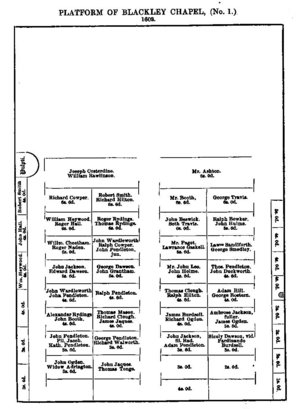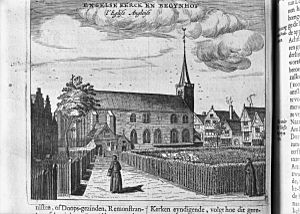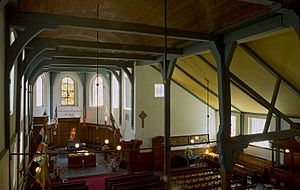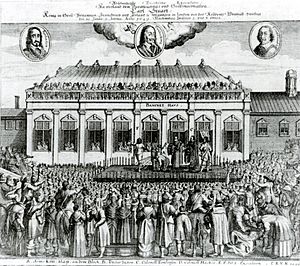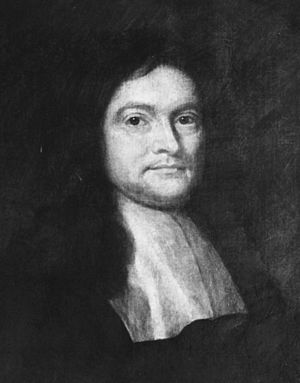Nathan Paget facts for kids
Quick facts for kids
Nathan Paget
|
|
|---|---|
| Born | March 1615 Blackley, Manchester.
|
| Died | January 1679 |
| Nationality | English |
| Education | University of Edinburgh, University of Leyden. |
| Known for | Collaborative work on rickets. Radical political and religious interests. Association with John Milton. |
| Spouse(s) | Elizabeth Cromwell, cousin of Oliver Cromwell. |
| Children | Childless |
| Parent(s) | Thomas Paget, Margery Goldsmith. |
| Scientific career | |
| Fields | Bubonic plague, rickets. |
| Institutions | University of Cambridge, College of Physicians. |
| Thesis | 'De Peste' (1639) |
| Influences | Daniel Whistler |
| Influenced | Francis Glisson, Samuel Hartlib, Elias Ashmole. |
Nathan Paget (1615–1679) was an English doctor who lived during a very exciting time in history. This included the English Civil War, the time when England was a republic (the Commonwealth), and after the king returned (the Restoration). Even though his job was usually quite traditional, Nathan Paget was keen on new ways of doing science. He was interested in experiments, which was a big part of the Enlightenment. He came from a strong Presbyterian family, but he also had some very new and bold ideas about politics and religion.
Contents
Nathan Paget's Family Background
Nathan Paget was born in Manchester, England, and was baptised on March 31, 1615. His family was quite important in their local community.
- Thomas Paget was Nathan's father. He was a minister at a place called Blackley. Later, he worked in other cities like Amsterdam, Shrewsbury, and Stockport. Blackley Chapel was part of a much bigger church, St Mary's Church, Manchester. Thomas Paget was a Puritan, a type of Protestant who wanted to make the Church of England simpler.
- Margery Goldsmith was Nathan's mother. She came from Nantwich and her family were merchants.
Nathan's parents got married in Nantwich in 1613. Nathan was their first child. He also had two younger sisters, Dorothy and Elizabeth.
His Early Life and Studies
Nathan Paget grew up in a family that often faced challenges because of their Puritan beliefs. His father, Thomas, had disagreements with the local bishops.
Nathan first went to Northwich grammar school. The head teacher there was a strong Calvinist, which was a type of Protestant belief. Things got harder for Puritans when King Charles I became king. Nathan's mother died in 1628.
In 1631, Nathan's father, Thomas, was in trouble with the law and faced fines. He had to go into hiding and then escaped with his family to the Dutch Republic (modern-day Netherlands).
In Amsterdam, the family found safety. Thomas helped his brother, John Paget, at the English Reformed Church. Nathan's education continued quickly. He went to the University of Edinburgh in Scotland and earned his Master of Arts degree in 1635. Scotland was safer for Puritans because it had a Presbyterian polity, a different church system.
Nathan's uncle, John Paget, was very good at many languages, especially ancient ones. He knew Chaldean, Syriack, Rabbinicall, and Arabick. This meant the Paget family likely learned a lot from the Jewish community in Amsterdam. Nathan became very interested in old languages himself.
After his uncle John died in 1638, Nathan decided to study medicine. On November 25, 1638, he joined the University of Leyden in the Netherlands. This university was one of the best in Europe for medicine. Nathan earned his Doctor of Medicine (M.D.) degree on August 3, 1639. His final paper was called De Peste (On the Plague). In it, he proudly called himself a "Mancunian and Englishman."
Building His Reputation
Nathan Paget returned to England just as big changes were happening. He was allowed to practice medicine outside London in 1640. He likely supported the Parliamentarian side in the coming war.
During the Civil War
In 1642, his medical degree was accepted at the University of Cambridge, which was a Puritan university. In 1643, Paget moved to Coleman Street in London. This area was known for its strong political and religious ideas. He married Elizabeth Cromwell, who was a cousin of Oliver Cromwell. At that time, Oliver Cromwell was not yet famous, but he would become a very important leader.
Paget promised to support a Presbyterian church system under the king. However, he also followed the teachings of John Goodwin, a more radical preacher. Paget became a Fellow of the College of Physicians in 1646. He gave the College a book by Francis Bacon, a famous philosopher who believed in learning through experiments. This showed Paget's interest in new scientific methods.
Success and Recognition
Over the next few years, Paget's connections became very helpful. His wife's cousin, Oliver Cromwell, became a powerful leader in the army. Also, Nathan's father, Thomas Paget, became an important figure in Shrewsbury. He strongly supported the execution of King Charles I, which was a very radical idea at the time.
After the king was executed, England became a republic. Nathan Paget had good connections with this new government. In 1649, he was made the doctor for the Tower of London by the Council of State.
Around 1645, Paget was one of seven doctors who started studying a disease called rickets. This disease was common in children. They wanted to understand it better. Francis Glisson became the main writer for their research.
Their book, Tractatus de Rachitide Sive Morbo Puerilii, was published in Latin in 1650. An English version came out the next year. Glisson made sure all the doctors who helped were named, including Paget. The book described the symptoms of rickets very well, like how it affected bones and chests. This helped doctors identify and study the disease for a long time.
In 1655, Paget was chosen for an important job at the College of Physicians. He became a Censor, which meant he helped make sure doctors followed the rules and were properly trained. He was chosen for this role again in 1657 and 1659.
His Friends and Connections
Paget had many friends and connections in science, politics, and culture. The doctors who worked on rickets together were a close group. Many of them, like Paget, had studied at Leyden University. One of them, Jonathan Goddard, even became Oliver Cromwell's personal doctor.
Paget also knew Samuel Hartlib, a German scientist. He also lent books on alchemy (an old form of chemistry) to Elias Ashmole, who was writing an important book about it.
Paget was a friend of John Milton, a famous English poet. Milton's third wife was actually Paget's cousin. It was Paget who introduced them! Paget also helped Milton find a reader when Milton became blind.
Paget had a very large library with over 2,000 books. It included Milton's works and many pamphlets about different religious groups, like the Quakers. He was interested in new religious ideas that were different from the main church teachings.
Paget's friends included people who spoke many languages, just like his own family. These connections helped him stay involved in the important intellectual discussions of his time.
Later Life and Career
Nathan Paget's father, Thomas, died in 1660. Nathan did not face major problems in his career when the king returned to power in 1660.
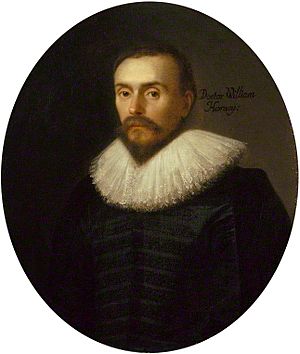
In 1663, Paget was chosen to give the Harveian lecture. This was a special speech created by William Harvey, a famous doctor who discovered how blood circulates. The lecture was an important event for doctors. A famous diarist, John Evelyn, wrote about attending Paget's lecture in 1664. The lecture was given in Latin and encouraged doctors to study nature through experiments.
Paget continued to be an important figure at the College of Physicians. He was elected Censor again in 1669 and 1678.
Marriage and Family
Nathan Paget married Elizabeth Cromwell around 1643. She was the daughter of Philip Cromwell, and a first cousin of Oliver Cromwell, who later became the powerful Lord Protector of England. Elizabeth Cromwell was likely around the same age as Nathan. She died before him. They did not have any children.
Family tree
| Nathan Paget and his relatives | |||||||||||||||||||||||||||||||||||||||||||||||||||||||||||||||||||||||||||||||||||||||||||||||||||||||||||||||||||||||||||||||||||||||||||||||||||||||||||||||||||||||||||||||||||||||||||||||||||||||||||||||||||||||||||||||||||||||||||||||||||||||||||||||||||||||||||||||||||||||||||||||||||||||||||||||||||||||||||||||||||||||||||||||||||||||||||||||||||||||||||||||||||||||||||||||||||||||||||||||||||||||||||||||||||||||||||||||||||||||||||||||||||||||||||||||||||||||||||||||||||||||||||||||||||||||||||||||||||||||||||||||||||||||||||||||||||||||||||||||||||||||||||||||||||||||||||||||||||||||||||||||||||||||||||||||||||||||||||||||||||||||||||||||||||||||||||||||||||||||||||||||||||||||||||||||||||||||||||||||||||||||||||||||||||||||||||||||||||||||||||||||||||||||||||
|---|---|---|---|---|---|---|---|---|---|---|---|---|---|---|---|---|---|---|---|---|---|---|---|---|---|---|---|---|---|---|---|---|---|---|---|---|---|---|---|---|---|---|---|---|---|---|---|---|---|---|---|---|---|---|---|---|---|---|---|---|---|---|---|---|---|---|---|---|---|---|---|---|---|---|---|---|---|---|---|---|---|---|---|---|---|---|---|---|---|---|---|---|---|---|---|---|---|---|---|---|---|---|---|---|---|---|---|---|---|---|---|---|---|---|---|---|---|---|---|---|---|---|---|---|---|---|---|---|---|---|---|---|---|---|---|---|---|---|---|---|---|---|---|---|---|---|---|---|---|---|---|---|---|---|---|---|---|---|---|---|---|---|---|---|---|---|---|---|---|---|---|---|---|---|---|---|---|---|---|---|---|---|---|---|---|---|---|---|---|---|---|---|---|---|---|---|---|---|---|---|---|---|---|---|---|---|---|---|---|---|---|---|---|---|---|---|---|---|---|---|---|---|---|---|---|---|---|---|---|---|---|---|---|---|---|---|---|---|---|---|---|---|---|---|---|---|---|---|---|---|---|---|---|---|---|---|---|---|---|---|---|---|---|---|---|---|---|---|---|---|---|---|---|---|---|---|---|---|---|---|---|---|---|---|---|---|---|---|---|---|---|---|---|---|---|---|---|---|---|---|---|---|---|---|---|---|---|---|---|---|---|---|---|---|---|---|---|---|---|---|---|---|---|---|---|---|---|---|---|---|---|---|---|---|---|---|---|---|---|---|---|---|---|---|---|---|---|---|---|---|---|---|---|---|---|---|---|---|---|---|---|---|---|---|---|---|---|---|---|---|---|---|---|---|---|---|---|---|---|---|---|---|---|---|---|---|---|---|---|---|---|---|---|---|---|---|---|---|---|---|---|---|---|---|---|---|---|---|---|---|---|---|---|---|---|---|---|---|---|---|---|---|---|---|---|---|---|---|---|---|---|---|---|---|---|---|---|---|---|---|---|---|---|---|---|---|---|---|---|---|---|---|---|---|---|---|---|---|---|---|---|---|---|---|---|---|---|---|---|---|---|---|---|---|---|---|---|---|---|---|---|---|---|---|---|---|---|---|---|---|---|---|---|---|---|---|---|---|---|---|---|---|---|---|---|---|---|---|---|---|---|---|---|---|---|---|---|---|---|---|---|---|---|---|---|---|---|---|---|---|---|---|---|---|---|---|---|---|---|---|---|---|---|---|---|---|---|---|---|---|---|---|---|---|---|---|---|---|---|---|---|---|---|---|---|---|---|---|---|---|---|---|---|---|---|---|---|---|---|---|---|---|---|---|---|---|---|---|---|---|---|---|---|---|---|---|---|---|---|---|---|---|---|---|---|---|---|---|---|---|---|---|---|---|---|---|---|---|---|---|---|---|---|---|---|---|---|---|---|---|---|---|---|---|---|---|---|---|---|---|---|---|---|---|---|---|---|---|---|---|---|---|---|---|---|---|---|---|---|---|---|---|---|---|---|---|---|---|---|---|---|---|---|---|---|---|---|---|---|---|---|---|---|---|---|---|---|---|---|---|---|---|---|---|---|---|---|---|---|---|---|---|---|---|---|---|---|---|---|---|---|---|---|---|---|---|---|---|---|---|---|---|---|---|---|---|---|---|---|---|---|---|---|---|---|---|---|---|---|---|---|---|---|---|---|---|---|---|---|---|---|---|---|---|---|---|---|---|---|---|---|---|---|---|---|---|---|---|---|---|---|---|---|---|---|---|---|---|---|
|
|||||||||||||||||||||||||||||||||||||||||||||||||||||||||||||||||||||||||||||||||||||||||||||||||||||||||||||||||||||||||||||||||||||||||||||||||||||||||||||||||||||||||||||||||||||||||||||||||||||||||||||||||||||||||||||||||||||||||||||||||||||||||||||||||||||||||||||||||||||||||||||||||||||||||||||||||||||||||||||||||||||||||||||||||||||||||||||||||||||||||||||||||||||||||||||||||||||||||||||||||||||||||||||||||||||||||||||||||||||||||||||||||||||||||||||||||||||||||||||||||||||||||||||||||||||||||||||||||||||||||||||||||||||||||||||||||||||||||||||||||||||||||||||||||||||||||||||||||||||||||||||||||||||||||||||||||||||||||||||||||||||||||||||||||||||||||||||||||||||||||||||||||||||||||||||||||||||||||||||||||||||||||||||||||||||||||||||||||||||||||||||||||||||||||||
His Death
Nathan Paget died in January 1679 at his home in London. He was 63 years old. In his will, he left his house to his half-brother, Thomas. He also left money to his cousins and to the poor people of his church. He gave money to the College of Physicians from properties he owned.
Paget's famous library, full of his many books, was sold after his death. A list of all his books was published in 1681.
Nathan Paget's Life in Maps
| Mapping Nathan Paget's life | ||||||||||||||||||||||||||||||||||||||||||||||||||||||||
|---|---|---|---|---|---|---|---|---|---|---|---|---|---|---|---|---|---|---|---|---|---|---|---|---|---|---|---|---|---|---|---|---|---|---|---|---|---|---|---|---|---|---|---|---|---|---|---|---|---|---|---|---|---|---|---|---|
|


